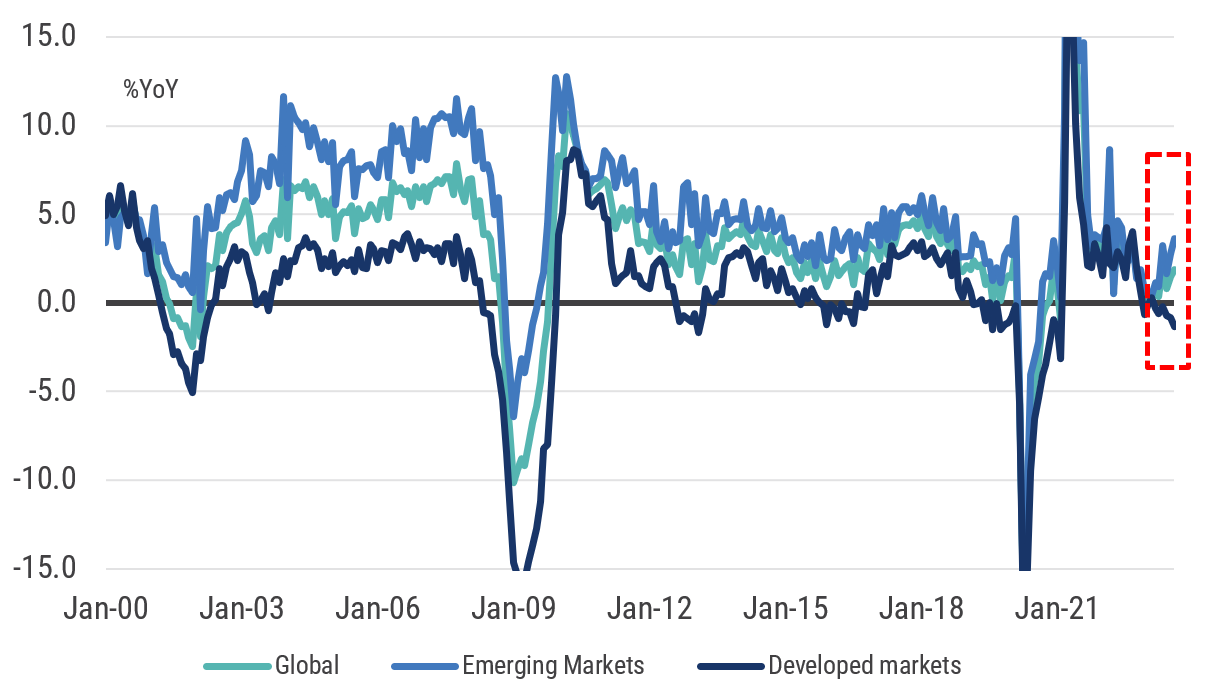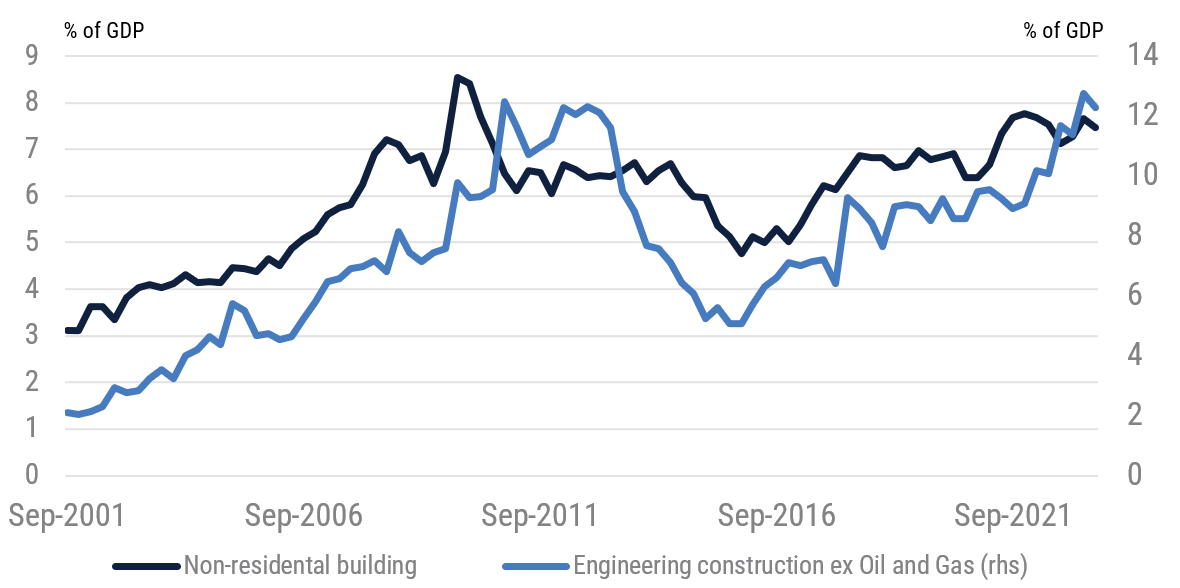What recession? Australia to accelerate through 2024
Reflation, not recession
Stronger economic growth and lower inflation are the core ingredients for gains in risk assets. So too is a declining list of geopolitical and financial risks, at least relative to 2023, that may otherwise derail the economic outlook.
We see five key reasons:
#1. Emerging Markets are leading the way: Emerging markets commenced their recovery in economic activity before mid-2023. Importantly, this momentum has continued to build into the concluding months of the calendar year, providing a good platform for 2024. Indeed, the recovery has been so impressive – led by India, Vietnam, Mexico and parts of emerging Europe – that the emerging markets have driven a sizeable recovery in global production at a time when developed markets are acting as a small net drag (refer Chart 1).
Chart 1 – Industrial production in Emerging Markets is driving the recovery

Source: Yarra Capital Management.
#2. Excess credit will further propel the recovery: It may seem strange to suggest that the world is in a state of excess credit growth given the degree of central bank tightening in the West and ongoing quantitative tightening. However, credit growth continues to exceed economic growth in the world’s major economies and this has historically provided a good lead to future economic growth (refer Chart 2).
Chart 2 – Central bank assets and US ISM suggest a more positive outlook

Source: Yarra Capital Management.
#3. Rate relief is on the way: Our forecasts call for the US to achieve its inflation target by April 2024 and we expect a Fed easing cycle to commence as soon as May 2024. Nevertheless, we are conscious that little spare capacity has been released in both product and labour markets through the down cycle, meaning there is less scope for large interest rate reductions delivered in prior cycles. Interest rate reductions will likely be directed at keeping real interest rates from rising as inflation normalises rather than seeking to implement large real interest rate reductions.
#4. The end is near for QT: One of the more interesting developments for financial markets to absorb in 2024 will likely be the end of the Fed’s silence over its desired terminal size of its balance sheet. The Fed will articulate a terminal balance sheet size in 1H24 and this will set the stopwatch ticking on the lifespan of quantitative tightening. We believe the Fed will settle for a much higher terminal balance sheet size than consensus appears to be contemplating as the Fed is wary of running down its reserve repo balance too quickly (already down 68% through 2023) and the risks that this presents to financial market stability. The Bank of England has also been making the case for a higher terminal balance sheet, suggesting that their QT program will also be wound down. In Europe and Australia, less ambitious QT policies are doing little to influence global liquidity, whilst in China there is evidence of a switch from QT back to QE. In the special case of Japan, there is just a continuation of what appears to be permanent QE. In short, the deadweight on the economic cycle of QT is finally giving way, which will provide some cyclical support for the economic recovery.
#5. China finally ”gets it”: We were subdued on China’s prospects going into 2023, and we held to that view until September when financial markets moved unilaterally bearish on China. Coincidentally, this was just when the economic data started to turn upwards and Chinese officials’ incremental steps to stimulate the economy ratcheted up a couple of steps. China recently approved an expansion of its budget deficit from 3.0% to 3.8% this financial year – a meaningful fiscal boost to demand growth – and also announced a boost to local government liquidity facilities. However, a further 0.8% of GDP stimulus is also likely to be forthcoming if reports of a looming RMB1trillion support package for urban renovation and affordable housing are accurate. In short, Chinese policymakers appear to have finally realised the difference between encouraging a shift to new drivers of economic growth and stifling the old drivers of China’s prior success. Policy is now more balanced and broadly supportive for a more sustained domestic economic recovery. Perhaps more importantly, President Xi has sought to dramatically de-escalate tensions with the West and in particular with the US. Whilst scepticism justifiably remains, a less confrontational stance between the world’s two great powers can only be viewed as a positive development.
As a consequence, we find our forecasts for the global economy will expand 3.6% – a significant 100ppts above the current consensus view.
The implications for Australia
We continue to suggest that not only will Australia avoid a recession, it will likely accelerate sequentially through 2024 with the improving global backdrop acting as a tailwind. No one should be disputing that 2023 likely felt like a recession for many Australians. A per capita recession and a negative income shock for those with young families and high debt has cascaded into weak discretionary spending as high interest rates coincided with surging insurance, utilities, rates, education and food prices.
Nevertheless, economic growth was held up by several unusual features this economic cycle vis-à-vis prior cycles. In particular, we would highlight:
#1. Commodity prices remained high: Commodity price strength continued to underwrite double digit nominal economic growth and profitability.
#2. Construction backlogs: Much has been made of the backlog of work in housing construction that has nullified the typical cyclical shock that is transmitted via the housing construction sector during rate hiking cycles. Approvals and affordability are at very poor levels, yet the level of home building has barely declined at all. The backlog in work yet to be done is now peaking at a very high level, suggesting we shouldn’t be looking at the housing sector as a source of new economic growth. Equally, we shouldn’t be expecting a precipitous collapse in 2024; that may come in 2025 if interest rates remain at current levels, but that is not our expectation (refer Chart 3). But less has been made of the backlogs in non-residential building (led by offices, warehouses, health and transport) which equates to 7% of GDP and the backlog of engineering construction (led by roads, railways, electricity and mining which equates to 16% of GDP. This enormous backlog of work has kept upward pressure on the labour market and on input prices at a time when a global slow down would typically have seen investment tumble between 10-15%.
Chart 3 – The construction and non-dwelling pipeline is significant

Source: Yarra Capital Management, ABS
#3. Buffers and Asset prices: Newly indebted households without other forms of income producing assets feel the full force of rate hikes. However, the economy-wide impact of interest rates is diluted the more that growth in income producing assets outstrip the growth in debt. The rising trend in net household assets as a share of income over time means that income from term deposits, financial assets and investment property ownership have all risen over time and all produce an income stream which – even after 13 rate hikes this cycle – is still in excess of the rise in interest payments on the outstanding debt. This explains the bifurcated nature of spending growth. Older and asset rich households are largely impervious to rate hikes and, as such, luxury spending categories remain strong. Conversely, younger indebted households cashflows have turned negative and spending is being seriously challenged. In aggregate, rate hikes pack less of punch compared to prior cycles, but the young and indebted are taking a disproportionate beating.
#4. Population pump priming: Net immigration has surged well through government projections taking population growth close to 2.5%yoy growth in 2H23. Quite simply, it is very difficult to record a recession with that type of population growth at your back. We do expect net migration to slow in 2024 as the government seeks to tighten up some education programs and entitlements, yet the risk remains that the flood of people entering Australia surprises on the upside until a more material rise in the unemployment rate is realised.
In the concluding weeks of 2023, some additional factors are worth noting which support a more positive outlook into 2024. Specifically:
We expect inflation to move into the top of the RBA’s target band before the end of 2024, setting up the prospect of the RBA easing in August and again in November.
- Commodity prices are rising again: A falling USD and stronger global demand has seen commodity prices rising in Q4 which will provide a fillip for profits, tax revenue and nominal economic growth.
- Fiscal support and tax cuts are coming: Despite pressure for change, Stage 3 income tax cuts remain an election commitment of the Federal government. Equivalent to 1.1% of disposable income, the cuts are skewed to higher income households which our analysis suggests over 50% will be saved. Nevertheless, with the Federal Budget in surplus, the RBA rate cycle likely complete and an election looming in 2025, it is likely that addition fiscal support will be announced in the first half of next year to support lower and middle income households.
- Inflation moderation will drive rate cuts: We expect inflation to move into the top of the RBA’s target band before the end of 2024, setting up the prospect of the RBA easing in August and again in November 2024. While we are expecting a relatively shallow rate easing cycle, it will likely come earlier than most expect and, importantly, the RBA has renewed firepower to drive a more powerful economic recovery should inflation surprise on the downside.
- Capex intentions have lifted: We were pleasantly surprised to see that the ABS measure of investment intentions rose through 2H23 and now suggests business investment will rise 10% in 2023-24. This is well above the RBA’s 1-2% forecast. Indeed, not only has business investment been robust, there are signs it is accelerating.
- Geopolitical de-escalation: There were no shortages of geopolitical risks unfolding through 2023. Yet as the year concludes it is notable that the Israel Hamas war has not spread, the Ukraine Russian war has settled into a stalemate post Ukraine’s failed offensive, while China and the US have sought to mend political fences. Meanwhile, Taiwan’s looming election in January has an outside chance of a China friendly candidate or coalition displacing the DPP, which may see a non-military resolution to the Taiwan issue. While tensions remain high in the South China Sea, some abatement in risk is detectable and a thaw in the China-Australia relationship should provide a tailwind for Australia’s export sector.
All these factors considered, we are relatively optimistic on the outlook for the Australian economy and constructive on the 2024 equity market outlook. We expect economic growth to average 2.25% (vs. consensus forecasts of 1.5%), bond yields to finish the year at 4.0%, the $A/$US to reach 74c, and Australian equities to return 10% in large caps and 15% in small caps. From a top-down perspective, we believe equity markets have entered the ‘early’ phase of the investment cycle, suggesting that Industrials, Materials, Financials, Technology and REITs will generally outperform the more defensive sectors.
Discover our outlook for 2024
Throughout December, we will be releasing all of our 2024 outlooks across the Yarra Capital suite of asset. Stay up to date with all our insights here.


